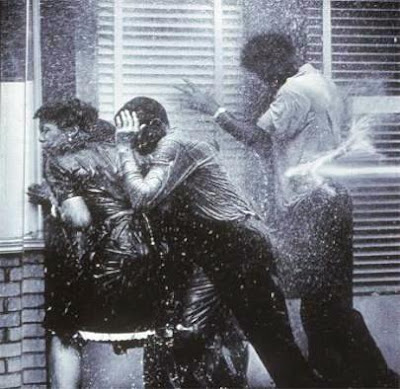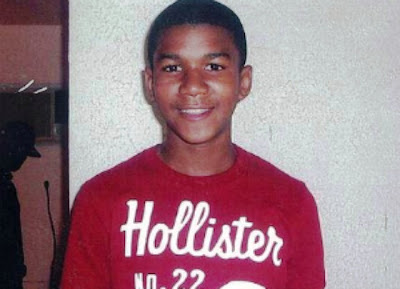“He said, ‘Somebody shot Trayvon and killed him.’ And I was like, ‘Are you sure?’ ” Fulton continued in disbelief. “I said ‘How do you know that’s Trayvon?’ And he said because they showed him a picture.”
That was Feb. 27, one day after Trayvon was shot. The father thought that he was missing, according to the family’s lawyer, Benjamin Crump, but the boy’s body had actually been taken to the medical examiner’s office and listed as a John Doe.
The father called the Missing Persons Unit. No luck. Then he called 911. The police asked the father to describe the boy, after which they sent officers to the house where the father was staying. There they showed him a picture of the boy with blood coming out of his mouth.
This is a nightmare scenario for any parent, and the events leading to Trayvon’s death offer little comfort — and pose many questions.
Trayvon had left the house he and his father were visiting to walk to the local 7-Eleven. On his way back, he caught the attention of George Zimmerman, a 28-year-old neighborhood watch captain, who was in a sport-utility vehicle. Zimmerman called the police because the boy looked “real suspicious,” according to a 911 call released late Friday. The operator told Zimmerman that officers were being dispatched and not to pursue the boy.
Zimmerman apparently pursued him anyway, at some point getting out of his car and confronting the boy. Trayvon had a bag of Skittles and a can of iced tea. Zimmerman had a 9 millimeter handgun.
The two allegedly engaged in a physical altercation. There was yelling, and then a gunshot.
When police arrived, Trayvon was face down in the grass with a fatal bullet wound to the chest. Zimmerman was standing with blood on his face and the back of his head and grass stains on his back, according to The Orlando Sentinel.
Trayvon’s lifeless body was taken away, tagged and held. Zimmerman was taken into custody, questioned and released. Zimmerman said he was the one yelling for help. He said that he acted in self-defense. The police say that they have found no evidence to dispute Zimmerman’s claim.
One other point: Trayvon is black. Zimmerman is not.
Trayvon was buried on March 3. Zimmerman is still free and has not been arrested or charged with a crime.
Yet the questions remain: Why did Zimmerman find Trayvon suspicious? Why did he pursue the boy when the 911 operator instructed him not to? Why did he get out of the car, and why did he take his gun when he did? How is it self-defense when you are the one in pursuit? Who initiated the altercation? Who cried for help? Did Trayvon’s body show evidence of a struggle? What moved Zimmerman to use lethal force?
This case has reignited a furor about vigilante justice, racial-profiling and equitable treatment under the law, and it has stirred the pot of racial strife.
As the father of two black teenage boys, this case hits close to home. This is the fear that seizes me whenever my boys are out in the world: that a man with a gun and an itchy finger will find them “suspicious.” That passions may run hot and blood run cold. That it might all end with a hole in their chest and hole in my heart. That the law might prove insufficient to salve my loss.
That is the burden of black boys in America and the people that love them: running the risk of being descended upon in the dark and caught in the cross-hairs of someone who crosses the line.
The racial sensitivity of this case is heavy. Trayvon’s parents have said their son was murdered. Crump, the family’s lawyer, told me, “You know, if Trayvon would have been the triggerman, it’s nothing Trayvon Martin could have said to keep police from arresting him Day 1, Hour 1.” Even the police chief recognizes this reality, even while disputing claims of racial bias in the investigation: “Our investigation is color blind and based on the facts and circumstances, not color. I know I can say that until I am blue in the face, but, as a white man in a uniform, I know it doesn’t mean anything to anybody.”
Zimmerman has not released a statement, but his father delivered a one-page letter to The Orlando Sentinel on Thursday. According to the newspaper, the statement said that Zimmerman is “Hispanic and grew up in a multiracial family.” The paper quotes the letter as reading, “He would be the last to discriminate for any reason whatsoever” and continues, “The media portrayal of George as a racist could not be further from the truth.” And disclosures made since the shooting complicate people’s perception of fairness in the case.
According to Crump, the father was told that one of the reasons Zimmerman wasn’t arrested was because he had a “squeaky clean” record. It wasn’t. According to the local news station WFTV, Zimmerman was arrested in 2005 for “battery on a law enforcement officer.”
Furthermore, ABC News reported on Tuesday that one of the responding officers “corrected a witness after she told him that she heard the teen cry for help.” And The Miami Herald published an article on Thursday that said three witnesses had heard the “desperate wail of a child, a gunshot, and then silence.”
WFTV also reported this week that the officer in charge of the scene when Trayvon was shot was also in charge of another controversial case. In 2010, a lieutenant’s son was videotaped attacking a black homeless man. The officer’s son also was not initially arrested in that case. He was later arrested when the television station broke the news.
Although we must wait to get the results from all the investigations into Trayvon’s killing, it is clear that it is a tragedy. If no wrongdoing of any sort is ascribed to the incident, it will be an even greater tragedy.
One of the witnesses was a 13-year-old black boy who recorded a video for The Orlando Sentinel recounting what he saw. The boy is wearing a striped polo shirt, holding a microphone, speaking low and deliberately and has the heavy look of worry and sadness in his eyes. He describes hearing screaming, seeing someone on the ground and hearing gunshots. The video ends with the boy saying, “I just think that sometimes people get stereotyped, and I fit into the stereotype as the person who got shot.”
And that is the burden of black boys, and this case can either ease or exacerbate it.




















